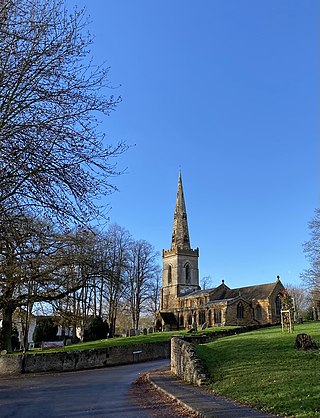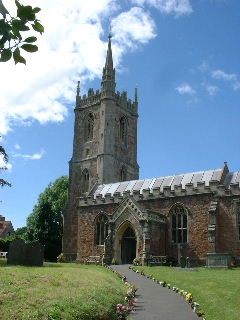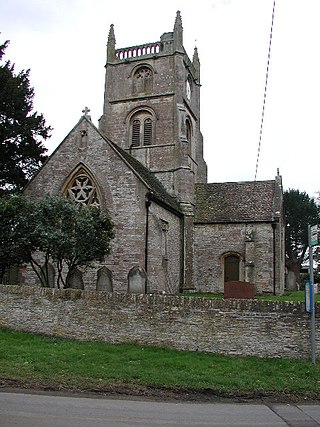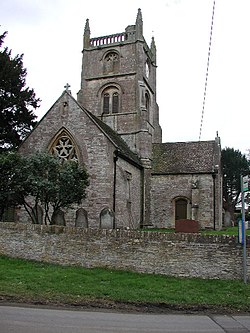
Kingsthorpe is a suburb and civil parish of Northampton, England. It is situated to the north of Northampton town centre and is served by the A508 and A5199 roads which join at Kingsthorpe's centre. The 2011 Census recorded the population of the district council ward as 4,477.

Bristol, the largest city in South West England, has an eclectic combination of architectural styles, ranging from the medieval to 20th century brutalism and beyond. During the mid-19th century, Bristol Byzantine, an architectural style unique to the city, was developed, and several examples have survived.

Priston is a civil parish and village 4 miles (6 km) south west of Bath in Bath and North East Somerset, which is within the English ceremonial county of Somerset. The parish includes the hamlet of Wilmington.

Wick St. Lawrence is a civil parish and village in Somerset, England. It falls within the unitary authority of North Somerset. The population of the parish, which includes Bourton, Icelton and Ebdon, in the 2011 census was 1,331.

There are 100 Grade I listed buildings in Bristol, England according to Bristol City Council. The register includes many structures which for convenience are grouped together in the list below.
There are 212 Grade II* listed buildings in Bristol, England.

St Mary the Virgin is a Church of England parish church in Henbury, Bristol, England.

The Anglican St Andrew's Church is on the outskirts of Chew Stoke, within the English county of Somerset. The church, parts of which date from the 15th century, is a Grade II* listed building.

Queen Charlton is a small village within the civil parish of Compton Dando, within the unitary authority area of Bath and North East Somerset in Somerset, England. The nearest town is Keynsham, which lies approximately 2 miles (3.2 km) north east of the village.

The Grade I listed buildings in Somerset, England, demonstrate the history and diversity of its architecture. The ceremonial county of Somerset consists of a non-metropolitan county, administered by Somerset County Council, which is divided into five districts, and two unitary authorities. The districts of Somerset are West Somerset, South Somerset, Taunton Deane, Mendip and Sedgemoor. The two administratively independent unitary authorities, which were established on 1 April 1996 following the breakup of the county of Avon, are North Somerset and Bath and North East Somerset. These unitary authorities include areas that were once part of Somerset before the creation of Avon in 1974.

The Church of St George in Ruishton, Somerset, England was built in the 14th to 16th centuries and has been designated as a grade I listed building.

The Church of St Mark in Mark, Somerset, England dates from the 13th century, but is mainly a 14th and 15th century building with further restoration in 1864. It has been designated as a Grade I listed building.

The Church of St Mary in Litton, Somerset, England, dates from the 13th century. It is a Grade I listed building.

The Church of St Margaret in Tintinhull, Somerset, England, dates from the 13th century and has been designated as a Grade I listed building.

The Church of St Peter and St Paul at Charlton Adam in the parish of Charlton Mackrell, Somerset, England has 14th-century origins, however most of the current building is from the 15th century. It has been designated as a Grade I listed building.

The Church of St Margaret in Hinton Blewett, Somerset, England probably dates from the 13th century although parts are as late as the 16th or 17th century. It has been designated as a Grade I listed building.

There are 72 Grade II* listed buildings in the city of Brighton and Hove, England. The city, on the English Channel coast approximately 52 miles (84 km) south of London, was formed as a unitary authority in 1997 by the merger of the neighbouring towns of Brighton and Hove. Queen Elizabeth II granted city status in 2000.

The Anglican Church of St Mary the Virgin in Stanton Drew, Somerset, England, was built in the 13th century. It is a Grade II* listed building.

Burnett is a small village within the civil parish of Compton Dando, approximately 500 metres (1,600 ft) from the River Chew in the Chew Valley within the unitary authority area of Bath and North East Somerset in Somerset, England. The nearest town is Keynsham, which lies approximately 3 miles (4.8 km) north of the village. The parish had an acreage of 608 acres (246 ha). It is within the Bristol/Bath Green Belt.


















